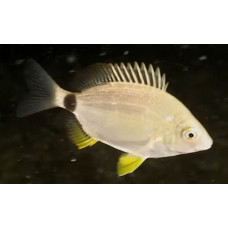Latin name
Diplodus annularis
Other names
Annular seabream (English), Sargu bishtzi (Albanian), Σπάρος (Sparos) (Greek), Hatabaat (Hebrew), Raspallón (Spanish), Sarago, Sparaglione (Italian), Ringelbrasse (German), Prażma (Polish), Sargo-alcorraz (Portuguese), Sparos (Romanian), Špar (Serbian, Slovenian, Croatian), Isparoz (Turkish), Sparaillon commun (French).
Identification
It has a deep, compressed body with an elongated ovoid shape. There are 8 incisors in the front of each jaw, with 1-3 rows of molars immediately behind the incisors.
Features of fish fins
The dorsal fin is supported by 11 spines and 11 to 13 soft rays, while the anal fin is supported by 3 spines and 11 or 12 soft rays.
Fish colouring
The overall colouration is silvery grey with a yellowish tinge, with an almost complete dark ring around the caudal peduncle just behind the dorsal and anal fins. The pelvic fins are yellowish and the rest of the fins are pale. Juveniles have shaved dark stripes and the ring on the caudal peduncle is complete.
Distribution
Occurs in the eastern Atlantic: Madeira, Canary Islands, also off Portugal, northwards to the Bay of Biscay, in the Mediterranean, Black and Azov Seas. A permanent resident of the Adriatic.
Habitat
Marine benthic pelagic fish. Lives at depths from 3 to 50 metres, near rocky shores covered with algae and rocky outcrops. Likes small sandy areas between aquatic vegetation.
Size
Reaches a length of 24 centimetres. Maximum published weight is 330g (12oz).
Behavior
It lives in small schools. In the cold season it goes out to sea and stays at great depths near the bottom. Quite a cautious fish.
Food and feeding habits
It feeds on diatoms, hydroids, sponges, polychaetes and crustaceans.
Reproduction
Hermaphroditism is systematically observed, meaning that the sex glands contain both male and female cells. Normally, most individuals develop only one of the two sets of sex cells and behave as normal males or females. But there are exceptions: there are fish that fulfil the role of males at an earlier age and then become females. Such hermaphrodites are called protandrics. Spawning lasts all summer, and the eggs float.
Fishing
It is fished commercially. In Sicily and the Adriatic, the fishery is semi-industrial, while elsewhere it is artisanal. It is also caught by recreational fishermen.
Relationship with a person
It is not highly valued as a food fish.
| Classification | |
| Phylum | Chordata |
| Class | Actinopterygii |
| Squad | Spariformes |
| Family | Sparidae |
| Genus | Diplodus |
| Species | D. annularis |
| Features | |
| Conservation status | Least Concern |
| Habitat | Pelagic |
| Life span, years | No information |
| Maximum body weight, kg | 0,33 |
| Maximum length, cm | 24 |
| Sailing speed, m/s | No information |
| Threat to people | Edible |
| Way of eating | Predator |
Annular seabream
Tags: annular seabream


